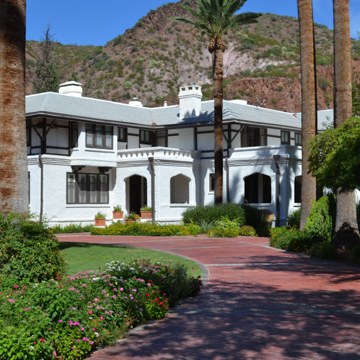You are here
Arizona Copper Company General Manager’s Residence
This is not the first “mansion” in the rough-and-tumble Clifton–Morenci–Metcalf mining district (that distinction belonged to the Mission Revival Del Potter Residence, built north of town in 1901), but the house built by the Arizona Copper Company (ACC) for its General Manager in 1913 was unlike anything Clifton had seen, before or since.
The house, easily the largest in the community, cost $25,000 to construct and was sited within formally landscaped grounds with a tennis court. It has an irregular plan, measuring 86 by 74 feet, with twenty rooms, including six bedrooms, each with a private bath. There are also four with private verandas, two entrance halls, and two staircases, along with a living room, formal dining room, library, and a recreation room. The commodious kitchen has two pantries and a powder room. Flooring was quarter-sawn oak and maple. Other features included several fireplaces, pebble-dash stucco on the exterior, and interior plaster. The style is a mix of Tudor Revival and Arts and Crafts, with touches of Prairie School. The architect is unknown, but the contractor was Mayfield and Shaw, who also built the new railway passenger depot directly across the river to the west.
The first tenant was Norman Carmichael, then the ACC general manager. The company also built several nearby Arts and Crafts–style houses for other ACC executives and engineers, all necessitated by construction of the depot directly across the river, on the site of their former residences.
Even after Phelps Dodge (PD) purchased all ACC holdings in 1922, PD branch managers continued to reside in this grand house, even though company offices were located in Morenci. After Lyle Barker retired as general manager in 1959, PD remodeled the elegant house at the river’s edge in Clifton and used it as a guest house for visiting company officials and as a venue for company-related special events. These functions continue today under Freeport–McMoran (FMI) ownership. Public access is restricted and must be arranged through FMI.
The associated houses were rendered uninhabitable in the flood of 1983 and they were subsequently demolished. The General Manager’s House survived, as did its immaculately groomed grounds, including tennis court and pergola. This remains the town’s most impressive residential complex. The building was listed in the National Register of Historic Places in 1990 as a contributor to the Clifton Townsite Historic District.
References
Garrett, William, and James Garrison. “Potter House, Clifton.” In 1973 Historical Architecture Calendar: Territorial Mansions of Arizona (April). Phoenix: First National Bank of Arizona.
Philips, David A., and Harris Sobin. Clifton’s Historic Buildings: A Flood Control-Related Cultural Resources Study of Clifton, Greenlee County, Arizona. U.S. Army Corps of Engineers, 1985.
Ryden Architects, Inc. Clifton Townsite Historic American Buildings Survey, Vol. 3. U.S. Army Corps of Engineers, 1995.
Zindel, Udo. Landscape Evolution in the Clifton-Morenci Mining District, Arizona, 1872-1986.Master’s thesis, Arizona State University, 1987.
Writing Credits
If SAH Archipedia has been useful to you, please consider supporting it.
SAH Archipedia tells the story of the United States through its buildings, landscapes, and cities. This freely available resource empowers the public with authoritative knowledge that deepens their understanding and appreciation of the built environment. But the Society of Architectural Historians, which created SAH Archipedia with University of Virginia Press, needs your support to maintain the high-caliber research, writing, photography, cartography, editing, design, and programming that make SAH Archipedia a trusted online resource available to all who value the history of place, heritage tourism, and learning.














